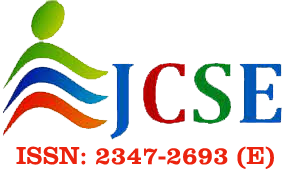An Effective Approach of Thinning for Morphological Features An Effective Approach of Thinning for Morphological Features
Kapila Sharma1
Section:Review Paper, Product Type: Journal Paper
Volume-3 ,
Issue-10 , Page no. 58-60, Oct-2015
Online published on Oct 31, 2015
Copyright © Kapila Sharma . This is an open access article distributed under the Creative Commons Attribution License, which permits unrestricted use, distribution, and reproduction in any medium, provided the original work is properly cited.
View this paper at Google Scholar | DPI Digital Library
How to Cite this Paper
- IEEE Citation
- MLA Citation
- APA Citation
- BibTex Citation
- RIS Citation
IEEE Citation
IEEE Style Citation: Kapila Sharma, “An Effective Approach of Thinning for Morphological Features An Effective Approach of Thinning for Morphological Features,” International Journal of Computer Sciences and Engineering, Vol.3, Issue.10, pp.58-60, 2015.
MLA Citation
MLA Style Citation: Kapila Sharma "An Effective Approach of Thinning for Morphological Features An Effective Approach of Thinning for Morphological Features." International Journal of Computer Sciences and Engineering 3.10 (2015): 58-60.
APA Citation
APA Style Citation: Kapila Sharma, (2015). An Effective Approach of Thinning for Morphological Features An Effective Approach of Thinning for Morphological Features. International Journal of Computer Sciences and Engineering, 3(10), 58-60.
BibTex Citation
BibTex Style Citation:
@article{Sharma_2015,
author = {Kapila Sharma},
title = {An Effective Approach of Thinning for Morphological Features An Effective Approach of Thinning for Morphological Features},
journal = {International Journal of Computer Sciences and Engineering},
issue_date = {10 2015},
volume = {3},
Issue = {10},
month = {10},
year = {2015},
issn = {2347-2693},
pages = {58-60},
url = {https://www.ijcseonline.org/full_paper_view.php?paper_id=704},
publisher = {IJCSE, Indore, INDIA},
}
RIS Citation
RIS Style Citation:
TY - JOUR
UR - https://www.ijcseonline.org/full_paper_view.php?paper_id=704
TI - An Effective Approach of Thinning for Morphological Features An Effective Approach of Thinning for Morphological Features
T2 - International Journal of Computer Sciences and Engineering
AU - Kapila Sharma
PY - 2015
DA - 2015/10/31
PB - IJCSE, Indore, INDIA
SP - 58-60
IS - 10
VL - 3
SN - 2347-2693
ER -
| |
|
|
| 2587 | 2426 downloads | 2531 downloads |
Abstract
Thinning is a challenging and important part while involvement with any image extraction process many works have been presented in this area, many thinning algorithms though have produced good results but still there needs a lot of improvement. Most of the algorithms based on thinning an image cannot justify the connectivity of various parts of the image. This paper presents algorithm for automated thinning of linear features by maintaining the integrity of pixels in order to maintain the connectedness. The connectivity of various pixels is achieved by traversing through the pixels and considering those pixels which have maximum number of neighbors. The iterative algorithm for thinning as presented in this paper takes the image into sections and represents each section as matrix to perform number of traversals. Thinning is an essential step of data compression useful in recognition and extraction of various morphological features from topographic sheets.
Key-Words / Index Term
Thinning, Morphological features
References
[1] G.S G.S.Ng, R.W.Zhou, C.Quek, A Novel Single Pass Thinning Algorithm, Nayang Technological University, School Of Applied Science, Research Laboratory II,Nayang Avenue,Singapore,2263.
[2] L. Liu1, E.W. Chambers2, D. Letscher2, and T. Ju1, A simple and robust thinning algorithm on cell complexes, 1Washington University in St. Louis, USA 2St. Louis University, USA Pacific Graphics 2010P. Alliez, K. Bala, and K. Zhou(Guest Editors)Volume 29 (2010), Number 7, Journal compilation c 2010 The Euro graphics Association and Blackwell Publishing Ltd.Published by Blackwell Publishing, 9600 Garsington Road, Oxford OX4 2DQ, UK and350 Main Street, Malden, MA 02148, USA.
[3] Lei Huang, Genxun Wan, Changping Liu, An Improved Parallel Thinning Algorithm, Institute of Automation, Chinese Academy of Sciences, P. R. China, Proceedings of the Seventh International Conference on Document Analysis and Recognition (ICDAR 2003).
[4] Jingliang Peng, An Efficient Algorithm of ThinninScanned pencil Drawings Computer Science Department, Peking University.
[5] Dongjun Xin, Xianzhong Zhou, Huali Zheng, Contour Line Extraction from Paper-based Topographic Maps College of Automation, Nanjing University of Science & Technology, Nanjing 210094 School of Management and Engineering, Nanjing university, Nanjing 210093 Artillery and Air DefencArmy Research Institute of Equipment & Technology,Beijing 100012
[6] R. Pradhan, S. Kumar, R. Agarwal, Mohan P. Pradhan & M. K. Ghose , Contour Line Tracing Algorithm for Digital Topographic Maps , International Journal of Image Processing (IJIP), Volume (4): Issue (2) , 2010.
